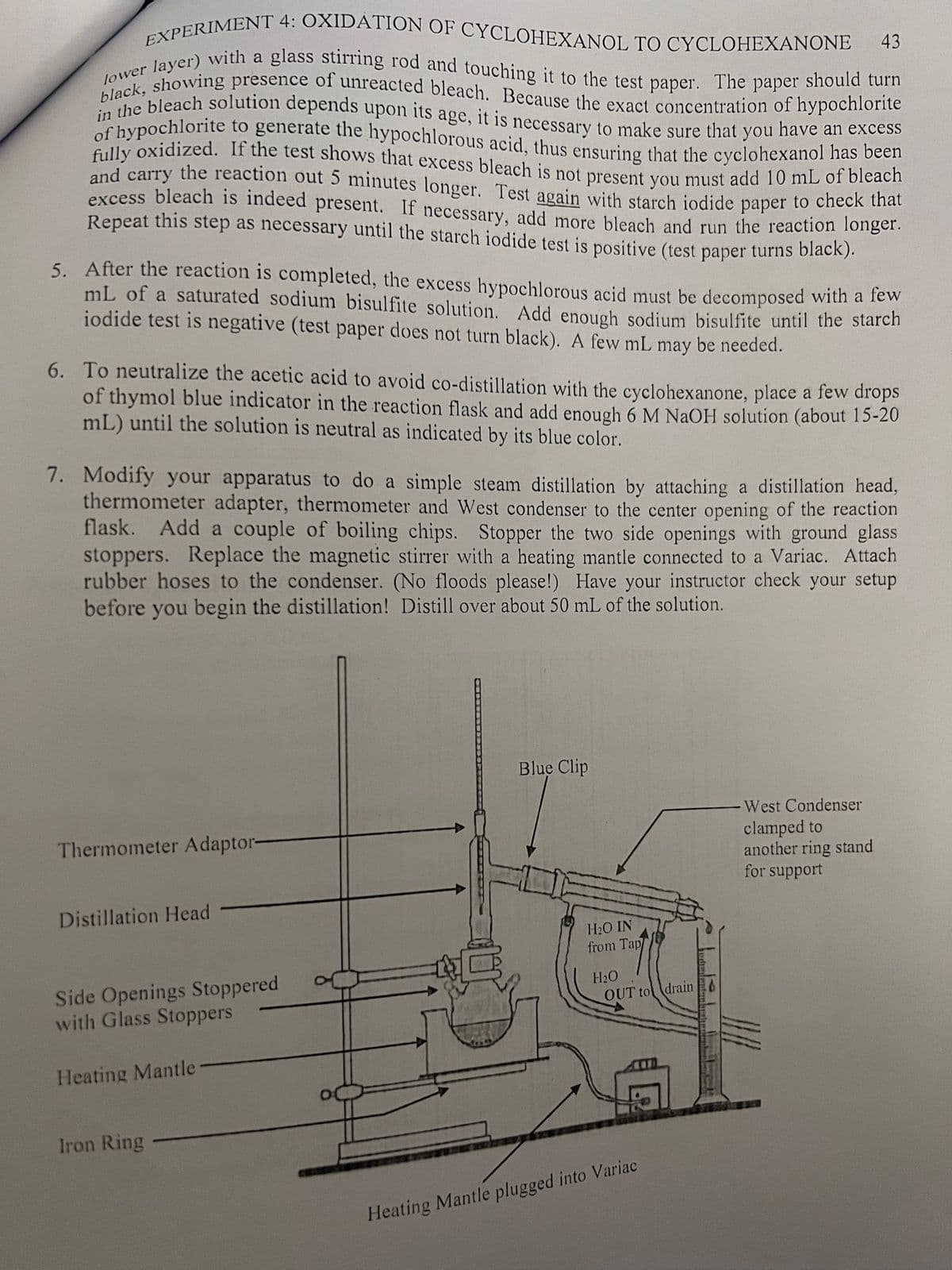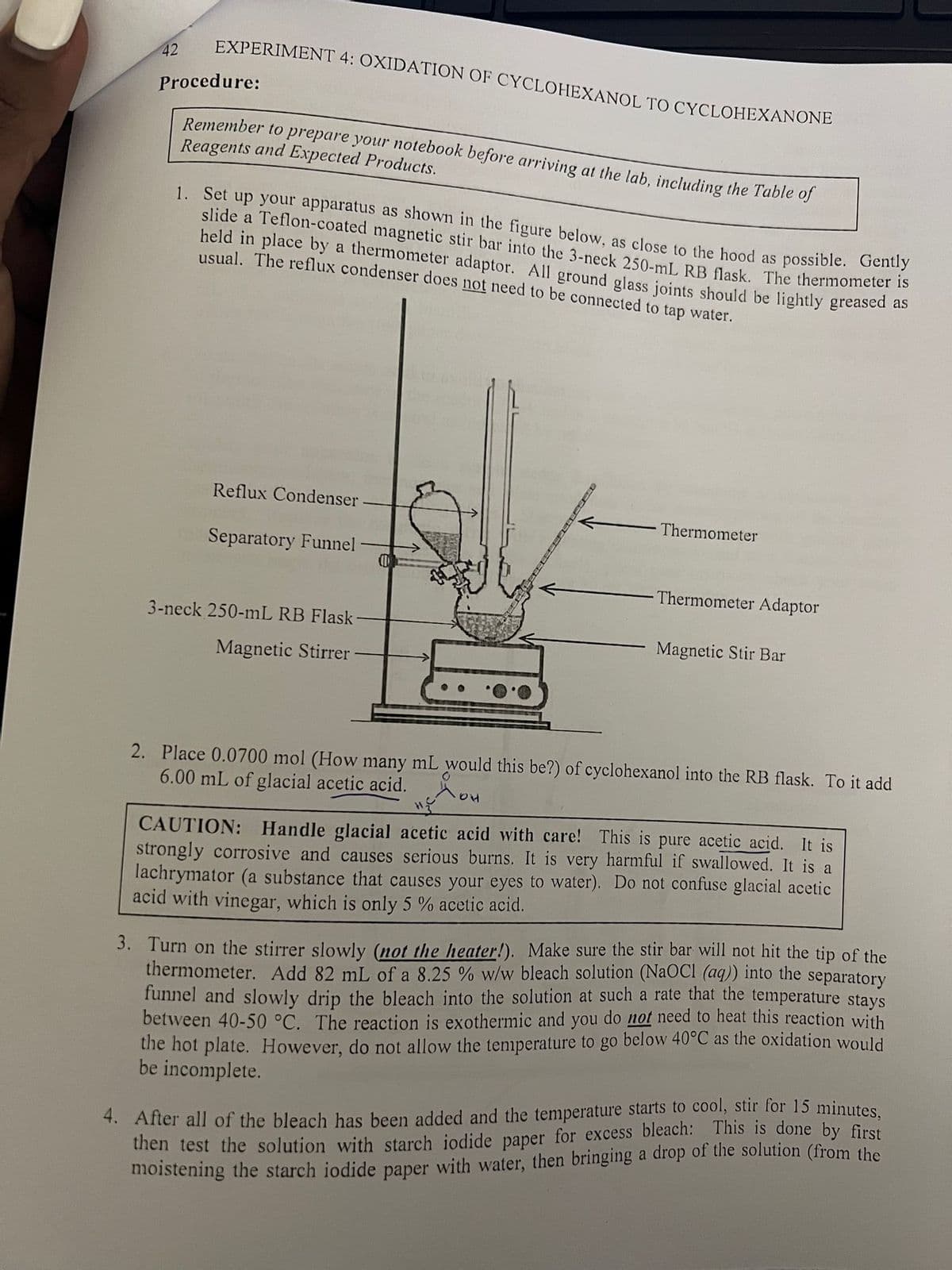Chapter90: High-performance Liquid Chromatography (hplc)
Section: Chapter Questions
Problem 1P
Related questions
Question
Please help me to calculate the mass, volume of cyclohexanone

Transcribed Image Text:EXPERIMENT 4: OXIDATION OF CYCLOHEXANOL TO CYCLOHEXANONE
black, showing presence of unreacted bleach. Because the exact concentration of hypochlorite
lower layer) with a glass stirring rod and touching it to the test paper. The paper should turn
in the bleach solution depends upon its age, it is necessary to make sure that you have an excess
of hypochlorite to generate the hypochlorous acid, thus ensuring that the cyclohexanol has been
and carry the reaction out 5 minutes longer. Test again with starch iodide paper to check that
fully oxidized. If the test shows that excess bleach is not present you must add 10 mL of bleach
excess bleach is indeed present. If necessary, add more bleach and run the reaction longer.
Repeat this step as necessary until the starch iodide test is positive (test paper turns black).
5. After the reaction is completed, the excess hypochlorous acid must be decomposed with a few
mL of a saturated sodium bisulfite solution. Add enough sodium bisulfite until the starch
iodide test is negative (test paper does not turn black). A few mL may be needed.
6. To neutralize the acetic acid to avoid co-distillation with the cyclohexanone, place a few drops
of thymol blue indicator in the reaction flask and add enough 6 M NaOH solution (about 15-20
mL) until the solution is neutral as indicated by its blue color.
7. Modify your apparatus to do a simple steam distillation by attaching a distillation head,
thermometer adapter, thermometer and West condenser to the center opening of the reaction
flask. Add a couple of boiling chips. Stopper the two side openings with ground glass
stoppers. Replace the magnetic stirrer with a heating mantle connected to a Variac. Attach
rubber hoses to the condenser. (No floods please!) Have your instructor check your setup
before you begin the distillation! Distill over about 50 mL of the solution.
Thermometer Adaptor-
Distillation Head
Side Openings Stoppered
with Glass Stoppers
Heating Mantle
Iron Ring
Blue Clip
H₂O IN
from Tap
H₂O
43
OUT to drain
Heating Mantle plugged into Variac
West Condenser
clamped to
another ring stand
for support

Transcribed Image Text:42
EXPERIMENT 4: OXIDATION OF CYCLOHEXANOL TO CYCLOHEXANONE
Procedure:
Remember to prepare your notebook before arriving at the lab, including the Table of
Reagents and Expected Products.
1. Set up your apparatus as shown in the figure below, as close to the hood as possible. Gently
slide a Teflon-coated magnetic stir bar into the 3-neck 250-mL RB flask. The thermometer is
held in place by a thermometer adaptor. All ground glass joints should be lightly greased as
usual. The reflux condenser does not need to be connected to tap water.
Reflux Condenser
Separatory Funnel-
3-neck 250-mL RB Flask-
Magnetic Stirrer
Thermometer
-Thermometer Adaptor
Magnetic Stir Bar
2. Place 0.0700 mol (How many mL would this be?) of cyclohexanol into the RB flask. To it add
6.00 mL of glacial acetic acid. Дон
CAUTION: Handle glacial acetic acid with care! This is pure acetic acid. It is
strongly corrosive and causes serious burns. It is very harmful if swallowed. It is a
lachrymator (a substance that causes your eyes to water). Do not confuse glacial acetic
acid with vinegar, which is only 5 % acetic acid.
3. Turn on the stirrer slowly (not the heater!). Make sure the stir bar will not hit the tip of the
thermometer. Add 82 mL of a 8.25 % w/w bleach solution (NaOCI (aq)) into the separatory
funnel and slowly drip the bleach into the solution at such a rate that the temperature stays
between 40-50 °C. The reaction is exothermic and you do not need to heat this reaction with
the hot plate. However, do not allow the temperature to go below 40°C as the oxidation would
be incomplete.
4. After all of the bleach has been added and the temperature starts to cool, stir for 15 minutes.
then test the solution with starch iodide paper for excess bleach: This is done by first
moistening the starch iodide paper with water, then bringing a drop of the solution (from the
Expert Solution
This question has been solved!
Explore an expertly crafted, step-by-step solution for a thorough understanding of key concepts.
Step by step
Solved in 2 steps

Knowledge Booster
Learn more about
Need a deep-dive on the concept behind this application? Look no further. Learn more about this topic, chemistry and related others by exploring similar questions and additional content below.Recommended textbooks for you

EBK A SMALL SCALE APPROACH TO ORGANIC L
Chemistry
ISBN:
9781305446021
Author:
Lampman
Publisher:
CENGAGE LEARNING - CONSIGNMENT

Macroscale and Microscale Organic Experiments
Chemistry
ISBN:
9781305577190
Author:
Kenneth L. Williamson, Katherine M. Masters
Publisher:
Brooks Cole

EBK A SMALL SCALE APPROACH TO ORGANIC L
Chemistry
ISBN:
9781305446021
Author:
Lampman
Publisher:
CENGAGE LEARNING - CONSIGNMENT

Macroscale and Microscale Organic Experiments
Chemistry
ISBN:
9781305577190
Author:
Kenneth L. Williamson, Katherine M. Masters
Publisher:
Brooks Cole